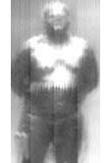Shadowy T-rays: Hunting Tumors and Exploring the Universe

X-rays picture broken bones. Microwaves warm leftovers. Both are parts of the electromagnetic spectrum, which also includes light and radio.
Meanwhile, little-known T-rays see through clothing, identify explosives and drugs, and detect tumors. Often overlooked, T-rays are even being used to explore the universe.
The electromagnetic spectrum runs from long-wavelength radio at one end to high-energy, short-wavelength X-rays and gamma rays on the other. Between microwaves and X-rays, in the least explored region of the spectrum, lie T-rays, or terahertz radiation, the most common form of radiation in the universe.
If you've never heard of T-rays, it's because scientists have had trouble harnessing them. Although the first scientific paper on the subject was published in the 1890's on the first page of the first issue of the journal Physical Review, the challenges of generating, detecting, and manipulating terahertz radiation have hindered the technology's research and development—until now.
With more efficient sources and detectors of terahertz radiation, researchers in the last decade have begun to develop waveguides, filters, and beam splitters to manipulate T-rays.
"At this point the technology is very young," said electrical engineer Daniel Mittleman, of Rice University's T-ray lab. "Terahertz is now where X-rays were in 1905," ten years after Wilhelm Conrad Rontgen discovered X-rays.
See right through
Sign up for the Live Science daily newsletter now
Get the world’s most fascinating discoveries delivered straight to your inbox.
Many everyday materials, such as clothing, plastics, and wood look transparent under terahertz imaging. In addition, materials will absorb the radiation at varying frequencies, depending on the type of material.
Based on absorption frequencies, researchers have been able to identify specific explosives and drugs that have unique "fingerprints."
For example, an envelope containing a white powder looks ambiguous and looms ominously to the naked eye. But with the help of T-ray imaging, a postal work could decipher whether the powdery parcel contained methamphetamine or aspirin. Explosive devices would be more easily spotted inside luggage.
T-rays are already being put to work.
The technology is being used in some hospitals as a novel, noninvasive diagnostic tool for doctors hunting tumors. The technique cuts costs and pain related to previous diagnostic tools. Scientists at the University of Liverpool, England, hope to kill skin cancer cells by bombarding them with terahertz radiation.
Cigarette manufacturers such as Phillip Morris are researching ways to use T-rays for quality control in the factory.
After cigarettes are packed inside cartons, the imaging systems check the moisture content and tobacco density of each cigarette. While former methods may have put workers at risk of radiation, T-rays in a factory setting are not hazardous.
"It's a hi-tech solution to a low-tech problem, but no low-tech solution is available," Mittleman said. "So the high-tech solution is the best solution."
Pharmaceutical companies are also employing hi-tech solutions, verifying the contents of their pills without putting a finger on a capsule. Terahertz imaging can even measure the thickness of a pill's coating.
Way-out applications
With the help of a T-ray imaging system made by a Michigan-based company called Picometrix, NASA can discover small defects of foam in the infamous space shuttle tiles.
T-rays have astronomical applications as well. The Herschel Space Observatory, a satellite due to launch in 2008 is the terahertz version of the Hubble telescope. In Chile, one of the world's largest telescope arrays, the Atacama Large Millimeter Array (ALMA), is being constructed; it will monitor terahertz wavelengths in hopes of spotting objects in the very early universe.
However, T-ray technology is still in its infancy, and Mittleman warns against the danger of overselling its capabilities.
"There's a long list of applications people have played with, but not thoroughly explored," he said. "I'm a firm believer that there will be success stories in some ideas. It will not surprise me if it's things we haven't even thought of yet."









